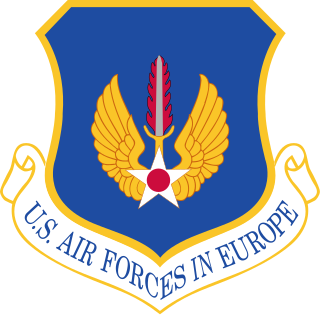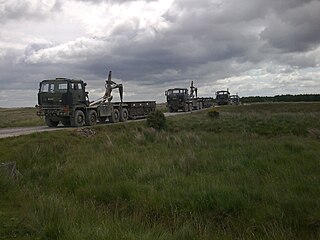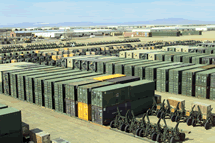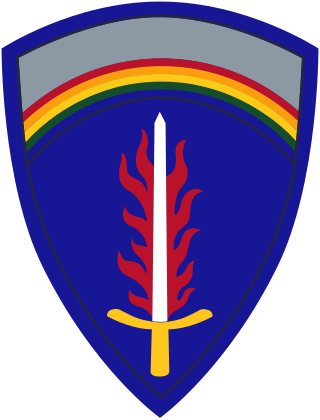
The Armed Forces of the Republic of Belarus are the military forces of Belarus. It consists of the Ground Forces and the Air Force and Air Defence Forces, all under the command of the Ministry of Defence. As a landlocked country, Belarus has no navy, however the Belarusian military does have control over some small Soviet inherited naval vessels in its rivers and lakes.

Mechanized infantry are infantry units equipped with armored personnel carriers (APCs) or infantry fighting vehicles (IFVs) for transport and combat.

Fort George G. Meade is a United States Army installation located in Maryland, that includes the Defense Information School, the Defense Media Activity, the United States Army Field Band, and the headquarters of United States Cyber Command, the National Security Agency, the Defense Courier Service, Defense Information Systems Agency headquarters, and the U.S. Navy's Cryptologic Warfare Group Six. It is named for George G. Meade, a Union general from the U.S. Civil War, who served as commander of the Army of the Potomac. The fort's smaller census-designated place includes support facilities such as schools, housing, and the offices of the Military Intelligence Civilian Excepted Career Program (MICECP).

A Combat Support Hospital is a type of modern United States Army field hospital. The CSH is transportable by aircraft and trucks and is normally delivered to the Corps Support Area in standard military-owned demountable containers (MILVAN) cargo containers. Once transported, it is assembled by the staff into a tent hospital to treat patients. Depending upon the operational environment, a CSH might also treat civilians and wounded enemy soldiers. The CSH is the successor to the Mobile Army Surgical Hospital (MASH).

Exercise Campaign Reforger was an annual military exercise and campaign conducted by NATO during the Cold War. The exercise was intended to ensure that NATO had the ability to quickly deploy forces to West Germany in the event of a conflict with the Warsaw Pact. Although most troops deployed were from the United States, the operation also involved a substantial number of troops from other NATO countries including Canada and the United Kingdom.

The United States Air Forces in Europe – Air Forces Africa (USAFE-AFAFRICA) is a United States Air Force (USAF) major command (MAJCOM) and a component command of both United States European Command (USEUCOM) and United States Africa Command (USAFRICOM). As part of its mission, USAFE-AFAFRICA commands U.S. Air Force units pledged to NATO, maintaining combat-ready wings based from the United Kingdom to Turkey. USAFE-AFAFRICA plans, conducts, controls, coordinates and supports air and space operations in Europe, parts of Asia and all of Africa with the exception of Egypt to achieve U.S. national and NATO objectives based on taskings by the two combatant commanders.

A combat medic is responsible for providing emergency medical treatment at a point of wounding in a combat or training environment, as well as primary care and health protection and evacuation from a point of injury or illness. Additionally, medics may also be responsible for the creation, oversight, and execution of long-term patient care plans in consultation with or in the absence of a readily available doctor or advanced practice provider. Combat medics may be used in hospitals and clinics, where they have the opportunity to work in additional roles, such as operating medical and laboratory equipment and performing and assisting with procedures.

Fort Barfoot, formerly Fort Pickett, is a Virginia Army National Guard installation, located near the town of Blackstone, Virginia. Home of the Army National Guard Maneuver Training Center, Fort Barfoot was originally named for the United States Army officer and Confederate General George Pickett. It was one of the U.S. Army installations named for Confederate soldiers that has been renamed by The Naming Commission. Their recommendation was for the post to be renamed Fort Barfoot, in honor of Medal of Honor recipient Colonel Van T. Barfoot. On 5 January 2023, William A. LaPlante, US Under Secretary of Defense for Acquisition and Sustainment, directed the full implementation of the recommendations of the Naming Commission, DoD-wide. The redesignation ceremony occurred on 24 March 2023.

The Demountable Rack Offload and Pickup System (DROPS) was a family of logistics vehicles formerly operated by the British Army, which consisted of two vehicle types:

The Bulgarian Land Forces are the ground warfare branch of the Bulgarian Armed Forces. It is administered by the Ministry of Defence, previously known as the Ministry of War during the Kingdom of Bulgaria. The Land Forces were established in 1878, when they were composed of anti-Ottoman militia (opalchentsi) and were the only branch of the Bulgarian military.

Engineer Battalion is a combat engineering battalion of the Estonian Defence Forces, based out of Tapa Army Base. The unit falls under the command of 1st Infantry Brigade of Estonian Land Forces.
Husterhoeh Kaserne was a military facility in Pirmasens, Rhineland-Palatinate, Germany. Kaserne is a German loanword that means "barracks." It was a United States military base 1945–1994. Since then it is a German base, most of which has closed. The base still has some US military operations and German military storage.

The M2 Bradley, or Bradley IFV, is an American infantry fighting vehicle that is a member of the Bradley Fighting Vehicle family. It is manufactured by BAE Systems Land & Armaments.

Sierra Army Depot (SIAD) is a United States Army post and military equipment storage facility located near the unincorporated community of Herlong, California. It was built in 1942 as one of several ammunition storage facilities located far enough inland to be safe from Japanese attack, yet close enough to western military posts and ports to facilitate shipment of supplies. The site also met the requirement that the depot be in a dry and isolated area.

The 10th Field Hospital is a Field Hospital of the United States Army first constituted on 23 June 1942 in the Army of the United States as the 10th Field Hospital.

United States Army Europe and Africa (USAREUR-AF) is an Army Service Component Command (ASCC) /Theater Army responsible for directing United States Army operations throughout the U.S. European Command (EUCOM) and U.S. Africa Command (AFRICOM) area of responsibility.

The Northwestern Operational Command (SZOK) is a command of the Belarus Ground Forces. It is headquartered at Borisov and is commanded by Major General Alexander Volfovich. The command includes a mechanized brigade and a mixed artillery brigade. It was formed in 2001 from the 65th Army Corps.

Romorantin - Pruniers Air Detachment is a French Air Force military facility, located 6 kilometres (3.7 mi) southwest of Romorantin-Lanthenay, in the Loir-et-Cher department of central France.

The People's Commissariat of Defence of the Soviet Union was the highest military department of the Soviet Union from 1934 to 1946.

Logistics played a key role in the success of Operation Dragoon, the Allied invasion of Southern France during World War II that commenced with the US Seventh Army landings on the French Riviera on 15 August 1944. On 12 September, the Seventh Army made contact with Allied forces that had landed in Normandy earlier that year as part of Operation Overlord. The supporting logistical organizations continued to operate separately, with the Southern Line of Communications supporting the Seventh Army drawing its supplies from the North African Theater of Operations until it merged with the Communications Zone of the European Theater of Operations on 20 November.



















